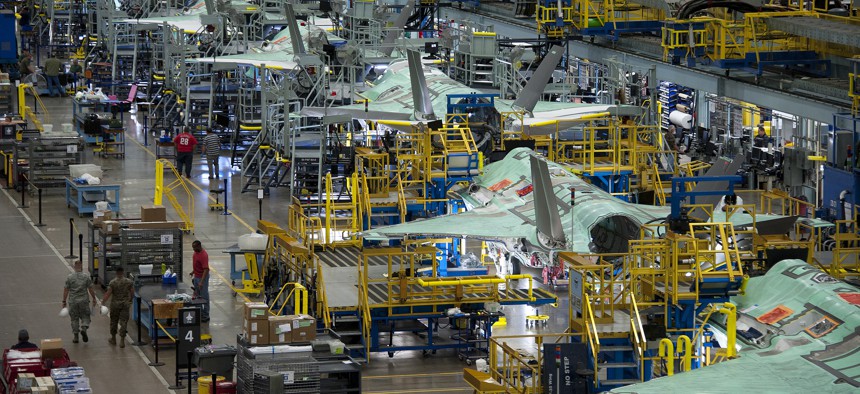
The F-35 production line in Fort Worth, Texas. Lockheed Martin
Trump Wants Chinese Parts Out of American Weapons
The White House will call for targeted investments in domestic manufacturing in an industrial-base report to be unveiled Friday.
The Pentagon intends to invest in domestic manufacturing to reduce its over-reliance on Chinese and other foreign-made parts in American weapons, top defense officials said Thursday.
The U.S. reliance on China is one of many areas discussed in a 146-page report about the health of the defense industrial base that President Trump is scheduled to release on Friday during an event at the White House. Other areas include “accelerating workforce development efforts to grow domestic science, technology, engineering, mathematics, and critical trade skills.”
“The assessment recognizes the global nature of our supply chains and really addresses the need for strengthening alliances and partnerships so that we can jointly address industrial base risk,” Ellen Lord, undersecretary for acquisition and sustainment, said Thursday evening during a briefing at the Pentagon.
Pentagon leaders will ask Congress for additional funding for mitigation efforts in its fiscal 2020 budget request to Congress early next year, defense officials said.
“We already have existing industrial-base mitigation tools,” said Eric Chewning, the deputy assistant defense secretary for industrial policy, said at the briefing. “There’s already money available to address some of these challenges.”
The report says China is the only producer of various chemicals needed in missiles and bombs, Japan and European nations are the only suppliers of certain carbon fibers used in missiles, satellites, and space rockets; Germany is the prime supplier of special vacuum tubes for night vision goggles, it says.
China is mentioned 232 times in the report, which has been been in the works for more than a year by a handful of government agencies. Much of the document’s findings and recommendations are classified because they describe areas of vulnerability in America’s supply chain. Chewning said a classified annex describes specific areas where the Pentagon will make its investments.
“I wouldn’t think of this just as an additional ask for money,” he said. “We also need to be spending what we do more wisely. This isn’t just an investment fix. There’s legislative fixes, there’s policy fixes, there’s regulatory fixes. We need to be able to hit all of those levers.”
It’s not simply that the U.S. hasn’t been investing in domestic manufacturing, he said. “Sometimes we’re just not spending money in the right way.”
Lord said the U.S. defense industry supports 2.4 million jobs and accounts for $865 billion “in annual industry output” and $143 billion in exports.
She said the report’s timing “is really excellent because it provides a site picture on industrial-base issues just as we receive the [2019] budget that really allows us to address many of those issues.”
Hawk Carlisle, president and CEO of the National Defense Industrial Association, said the report paints a “sobering picture” of the defense industrial base. NDIA was one of several trade groups that participated in the administration’s review.
“Reliance on single producers within the supply chain, dependence on unstable or unfriendly foreign suppliers for critical components, and misplaced presumption of continued preeminence of American military superiority are examples of findings that should be immediately addressed,” Carlisle, a retired Air Force general, said in a statement.
The Aerospace Industries Association, another trade group that participated in the review, issued this statement: “Ultimately, while it is essential that the Administration focus on addressing the specific challenges facing the industrial base, none of the advancements in acquisition policy, key capabilities or workforce will matter without adequate DOD budgets.”
